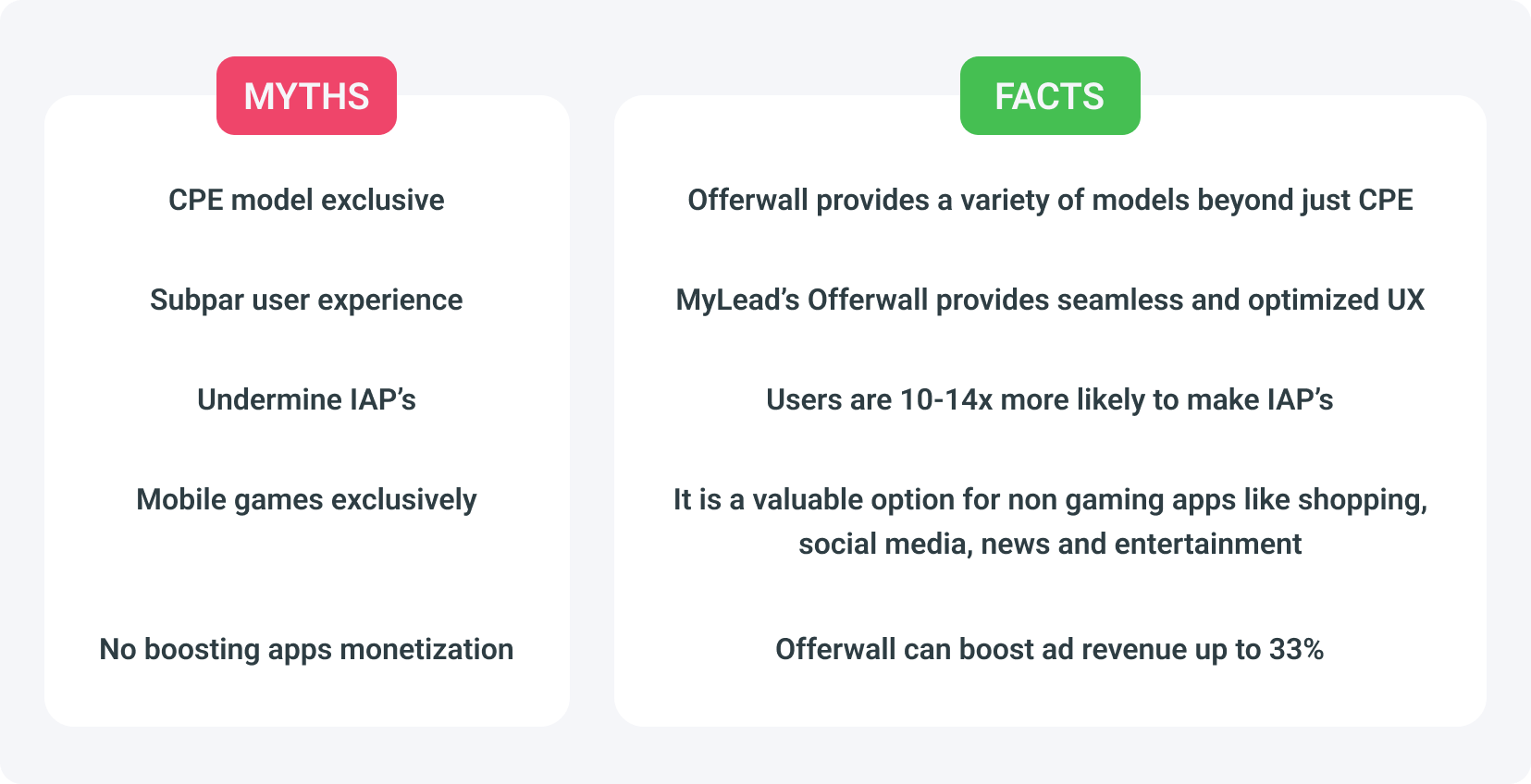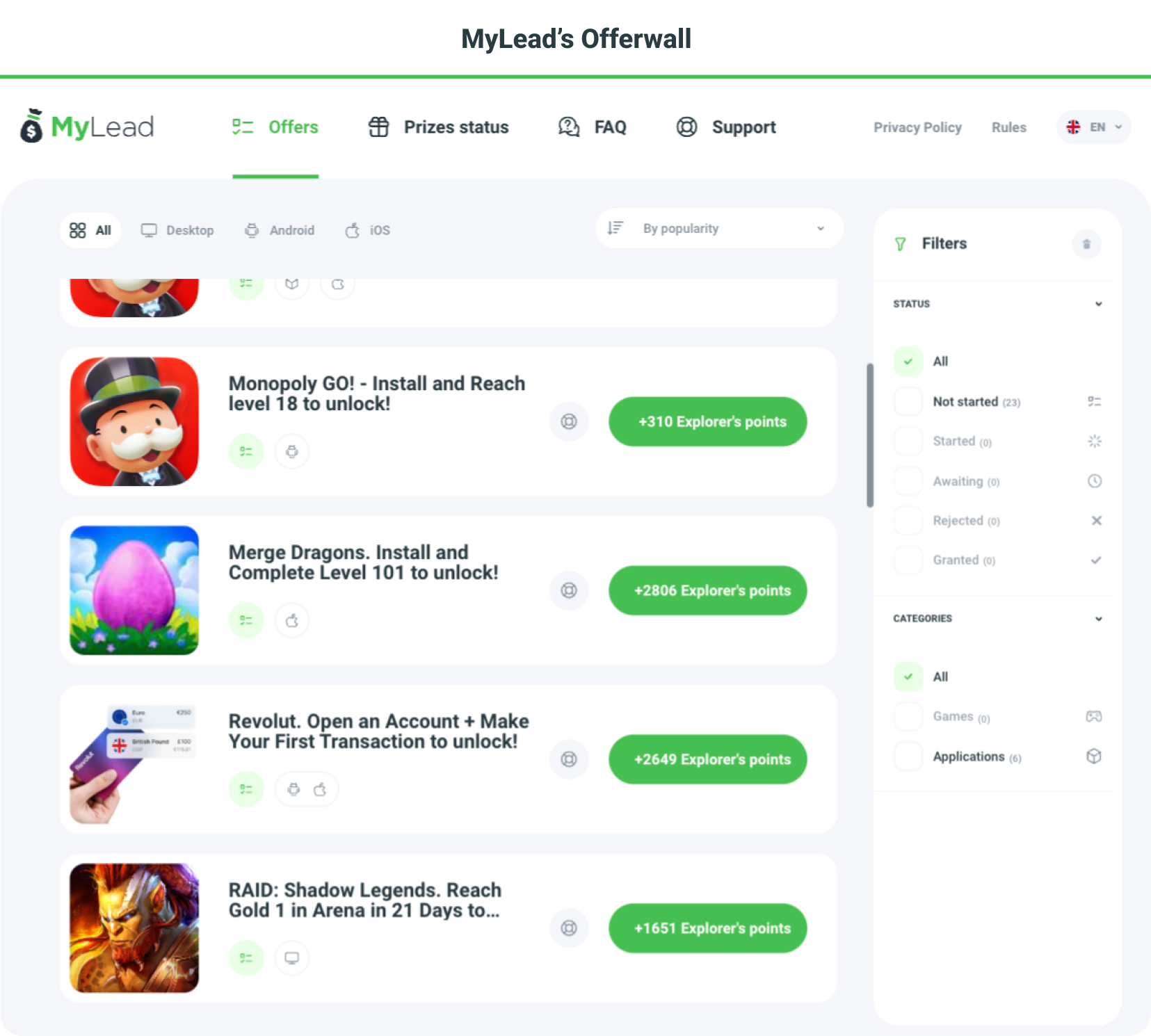
Blog / Tools
Facts and myths about Offerwall
This article is updated regularly
Last update:
25 August 2025
Monetizing mobile apps has become a key element of success for developers, but unfortunately, many people overlook the potential that the Offerwall tool brings. Users can benefit from Offerwalls, and they love it. As reported in the Ultimate Offerwall Guide, 70% of mobile gamers say they love rewarded ads. In fact, 47% of them say that it’s their favorite way to get virtual premium currency in mobile games. Offerwall users embrace rewarded ads as a natural part of the mobile gaming experience; 79.1% of users complete rewarded ads weekly, including 41% of them daily! Additionally, 43% of gamers say they’ve bought something they saw in a rewarded ad. These stats at the beginning of the article should show you that Offerwalls are liked and appreciated by a large group of users.
Further in this article, we aim to dispel certain myths and show why not using Offerwall is a significant mistake. There are numerous benefits that discourage users from utilizing this form of monetization, but the truth is that Offerwall can be an effective revenue-generating tool.
Before we address popular myths about Offerwall, you should check out an article about the benefits of using Offerwall, which you can take advantage of as a mobile game developer.
Popular myths about Offerwall

Take a look at the most popular myths about the Offerwall tool. In this paragraph, we will delve into some of the most common myths surrounding Offerwalls, shedding light on the relatives and dispelling these common myths.
MYTH: Offerwall is based on the CPE model only
Let’s start with what the CPE model is. CPE is the cost incurred by advertisers for each user engagement with specific content or ads. Engagement can include various actions such as clicks, likes, shares, comments, video views, or completing a specific activity in a game, depending on the platform and type of content. There is a common misconception that the CPE model is the exclusive model offered for Offerwalls. While it is the prevailing model in many apps, alternative options do exist. It’s essential to note that, in certain cases, CPE might be the sole option with some providers, but not with MyLead.
FACT: With our Offerwall, you are free to choose between CPI, CPA, CPL or CPS models.
It’s important to recognize that the Offerwall landscape provides a variety of models beyond just CPE, allowing developers to tailor their monetization approach based on their specific goals and preferences.
MYTH: Offerwalls deliver a subpar user experience

Although Offerwalls were once associated with inconvenience and complexity, those days are now a thing of the past.
FACT: In the current market landscape, Offerwalls, exemplified by platforms like MyLead, offer a seamless and optimized user experience.
However, user experience is not solely dependent on the actual performance. Users now enjoy a diverse array of options when engaging with offers, ensuring that the interaction is well-suited to each individual case. Offerwalls data shows that users are often satisfied with the opportunity to fill surveys or watch an ad video. As in the Ultimate Offerwall Guide, 79.2% of users who started the survey, completed it. As you can see, users likely completing Offerwalls tasks, they are engaged with this tool.
MYTH: Offerwall undermine In-App Purchases

There is a common misconception that integrating Offerwall into mobile apps undermines the effectiveness of In-App Purchases.
FACT: Contrary to this belief, Offerwalls don’t inherently sabotage IAP’s but provide an alternative way for users to access rewards or premium features.
In fact, Offerwalls have the opposite effect. The concern is that users might choose free options from Offerwalls, diverting potential revenue from direct in-app purchases. According to the MafAd article, 43% of gamers say they’ve bought something they saw in a rewarded ad. However, with a balanced approach, both monetization methods can coexist effectively, enhancing user engagement and providing developers with additional opportunities without negatively impacting in-app transactions.
MYTH: Offerwalls are made exclusively for mobile games
It's a popular myth that Offerwalls are designed solely for mobile games. In reality, they have evolved beyond gaming apps and are now successfully implemented across various mobile applications. Whether it’s productivity tools, utility apps, or entertainment platforms, offerwalls provide a versatile monetization strategy for developers.
FACT: The myth stems from the initial association of Offerwalls with mobile games.
Their adaptability and effectiveness have expanded their use to diverse app categories. Offerwall monetization can also be a valuable option for non-gaming apps like shopping, social media, news and entertainment apps. Developers across industries can leverage Offerwalls to enhance user engagement, provide value, and generate revenue, breaking the misconception that they are exclusive to the realm of mobile games.
MYTH: Offerwalls are not boosting apps monetization

Contay to a common misconception, Offerwalls can significantly enhance app monetization. Offerwall provides a valuable avenue for users to engage with relevant offers, generating additional revenue streams for developers.
FACT: The myth likely arises from outdated perceptions, as modern Offerwall implementations are designed to optimize user experience, resulting in increased user participation and, consequently, improved monetization.
By offering users a non-intrusive way to interact with advertisements, complete tasks, or participate in surveys, Offerwalls create a win-win scenario. Users receive rewards, and developers benefit from increased monetization opportunities.
MYTH: Offerwall excludes different monetization ways in my app
Dispelling the myth that implementing an Offerwall in mobile apps limits monetization options, it’s important to recognize that Offerwalls are versatile and can effectively cooperate with various ad formats.
FACT: Contrary to the misconception that Offerwalls stand alone, they seamlessly integrate with different monetization strategies.
By incorporating Offerwalls, your app not only can provide users with the opportunity to engage voluntarily with advertisements but also maintains compatibility with diverse ad formats. This strategic integration ensures a multifaceted approach to revenue generation, fostering a balanced and user-friendly experience that goes beyond the confines of traditional monetization methods.
Conclusion
In summary, Offerwalls debunk common myths surrounding their effectiveness in mobile app monetization. Contrary to misconceptions, they offer various models beyond CPE, providing flexibility for developers. Modern Offerwalls, exemplified by platforms like MyLead, ensure a seamless and optimized user experience, dispelling the notion of subpar interactions.

The belief that Offerwalls undermine In-App Purchases is debunked as they provide an alternative without sabotaging direct transactions. Offerwalls have evolved beyond gaming apps and are successfully implemented across diverse categories, challenging the misconception of exclusivity to mobile games.
Contrary to the myth that Offerwalls do not boost app monetization, they significantly contribute by offering users non-intrusive engagement with advertisements, tasks, or surveys. This win-win scenario enhances user participation, improves monetization, and creates a positive user experience.
In essence, Offerwalls represent a versatile tool for developers to diversify revenue streams, enhance engagement, and create a mutually beneficial environment in the mobile app ecosystem. Ignoring their potential could be a significant mistake for developers seeking optimal success.

